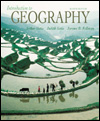 |  Introduction to Geography, 8/e Arthur Getis,
San Diego State University
Judith Getis
Jerome D. Fellmann,
University of Illinois, Urbana-Champaign
Urban Geography
Objectives:After reading and studying this chapter you should be able to:
1.
Understand the difference between urbanization and urban growth.
|
 |  |  | 2.
Identify the most and least rapidly urbanizing areas of the world and be able to explain the difference in
demographic terms.
|
 |  |  | 3.
Differentiate between the legal city, urbanized areas and metropolitan areas.
|
 |  |  | 4.
Classify locational attributes of a city as being either site or situation characteristics.
|
 |  |  | 5.
Describe the major features of Central Place Theory.
|
 |  |  | 6.
Separate the economic activities of a city into basic and nonbasic and calculate the employment
multiplier from a set of employment figures for basic and nonbasic sectors.
|
 |  |  | 7.
Describe the idealized land use distribution of both western and non-western cities and explain why the
patterns exist as they do.
|
 |  |  | 8.
Describe the three criteria used to identify urban social areas and explain their spatial patterns in cities.
|
 |  |  | 9.
Explain the factors that promote suburbanization and central city change.
|
 |  |  | 10.
Describe the process of gentrification.
|
 |  |  | 11.
Explain the differences in urbanization and urban structure between developed and developing parts of the
world.
|
|



 2002 McGraw-Hill Higher Education
2002 McGraw-Hill Higher Education